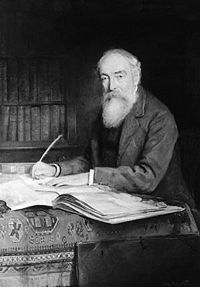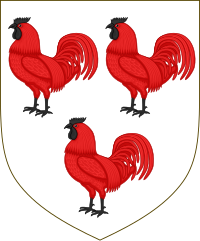
Earl of Lindsey is a title in the Peerage of England. It was created in 1626 for the 14th Baron Willoughby de Eresby. He was First Lord of the Admiralty from 1635 to 1636 and also established his claim in right of his mother to the hereditary office of Lord Great Chamberlain of England. Lord Lindsey fought on the Royalist side in the Civil War and was mortally wounded at the Battle of Edgehill on 23 October 1642. He was succeeded by his son, the second Earl. He also fought at Edgehill and surrendered to the Parliamentarians in order to attend his mortally wounded father. Lord Lindsey later fought at the First Battle of Newbury, Second Battle of Newbury, and at Naseby. His son from his second marriage, James, was created Earl of Abingdon in 1682. He was succeeded by his son from his first marriage to Martha Cockayne, the third Earl. He represented Boston in the House of Commons and served as Lord Lieutenant of Lincolnshire.

Earl of Abingdon is a title in the Peerage of England. It was created on 30 November 1682 for James Bertie, 5th Baron Norreys of Rycote. He was the eldest son of Montagu Bertie, 2nd Earl of Lindsey by his second marriage to Bridget, 4th Baroness Norreys de Rycote, and the younger half-brother of Robert Bertie, 3rd Earl of Lindsey. His mother's family descended from Sir Henry Norris, who represented Berkshire and Oxfordshire in the House of Commons and served as Ambassador to France. In 1572 he was summoned by writ to Parliament as Lord Norreys de Rycote. He was succeeded by his grandson, the second Baron. In 1621, he created Viscount Thame and Earl of Berkshire in the Peerage of England. He had no sons and on his death in 1624 the viscountcy and earldom became extinct. He was succeeded in the barony by his daughter Elizabeth, the third holder of the title. On her death, the title passed to her daughter, the aforementioned Bridget, the fourth Baroness, and second wife of the second Earl of Lindsey.

Earl Ferrers is a title in the Peerage of Great Britain. It was created in 1711 for Robert Shirley, 14th Baron Ferrers of Chartley. The Shirley family descends from George Shirley of Astwell Castle, Northamptonshire. In 1611 he was created a Baronet, of Staunton Harold in the County of Leicester, in the Baronetage of England. He was succeeded by his son Henry, the second Baronet, who married Lady Dorothy Devereux, daughter of Robert Devereux, 2nd Earl of Essex. On the death of her brother Robert Devereux, 3rd Earl of Essex, she became the youngest co-heir to the baronies of Ferrers of Chartley and the barony of Bourchier, which had fallen into abeyance on the death of the third Earl. Shirley was succeeded by his eldest son, the third Baronet. He died unmarried and was succeeded by his younger brother, the fourth Baronet. He was imprisoned in the Tower of London by Cromwell and died there in 1656. On his death the title passed to his eldest son, the fifth Baronet. He died at an early age and was succeeded at birth by his posthumous son, the sixth Baronet.

Earl of Romney is a title that has been created twice.

Earl of Limerick is a title that has been created twice in the Peerage of Ireland, associated first with the Dongan family, then with the Pery family.

Viscount Boyne, in the province of Leinster, is a title in the Peerage of Ireland. It was created in 1717 for the Scottish military commander Gustavus Hamilton, 1st Baron Hamilton of Stackallan. He had already been created Baron Hamilton of Stackallan, in the County of Meath in 1715, also in the Peerage of Ireland. Hamilton was the youngest son of Sir Frederick Hamilton, youngest son of Claud Hamilton, 1st Lord Paisley, third son of James Hamilton, 2nd Earl of Arran. His grandson, the second Viscount, represented Newport in the House of Commons. His first cousin, the fourth Viscount, sat as a member of the Irish House of Commons for Navan.

Viscount Gage, of Castle Island in the County of Kerry of the Kingdom of Ireland, is a title in the Peerage of Ireland. It was created in 1720 for Thomas Gage, along with the subsidiary title of Baron Gage, of Castlebar in the County of Mayo, also in the Peerage of Ireland. In 1744 he also succeeded his cousin as eighth Baronet, of Firle Place. The titles remain united. The Gage family descends from John Gage, who was created a baronet, of Firle Place in the County of Sussex, in the Baronetage of England on 26 March 1622. His great-grandson, the seventh Baronet, represented Seaford in Parliament. He was succeeded by his first cousin, Thomas Gage, 1st Viscount Gage, the eighth Baronet. He sat as a Member of Parliament for Minehead and Tewkesbury and also served as Governor of Barbados. In 1720, 24 years before succeeding in the baronetcy, he was raised to the Peerage of Ireland as Baron Gage and Viscount Gage. His second son was the military commander the Hon. Thomas Gage.

Viscount Hardinge, of Lahore and of Kings Newton in the County of Derby, is a title in the Peerage of the United Kingdom. It was created in 1846 for the soldier and Tory politician Sir Henry Hardinge. His son, the second Viscount, represented Downpatrick in Parliament. His great-great-grandson, the sixth Viscount, succeeded a distant relative as eighth Baronet, of Belle Isle in the County of Fermanagh, in 1986. This title had been created in the Baronetage of the United Kingdom 1801 for Richard Hardinge. He was the third son of Nicolas Hardinge, younger brother of Reverend Henry Hardinge and uncle of the latter's third son Henry Hardinge, 1st Viscount Hardinge. The baronetcy was created with special remainder to the heirs male of Richard Hardinge's father.

Viscount Knutsford, of Knutsford in the County Palatine of Chester, is a title in the Peerage of the United Kingdom.
Viscount Camrose, of Hackwood Park in the County of Hampshire, is a title in the Peerage of the United Kingdom. It was created on 20 January 1941 for the prominent newspaper magnate William Berry, 1st Baron Camrose. He had previously received the award of Baronet, of Long Cross in the County of Surrey, in the Baronetage of the United Kingdom, on 4 July 1921, and was created Baron Camrose, of Long Cross in the County of Surrey, on 19 June 1929, in the Peerage of the United Kingdom. His second son, the third Viscount, disclaimed the peerages in 1995 on succeeding his elder brother. However, he had already been created a life peer as Baron Hartwell, of Peterborough Court in the City of London, on 19 January 1968. On his death in 2001 the life peerage became extinct while he was succeeded in the other titles by his eldest son, the fourth Viscount. The first three Viscounts all headed The Daily Telegraph at one point, the first having purchased it from Harry Levy-Lawson, 1st Viscount Burnham, but in the 1980s they lost control to Conrad Black.

Viscount Scarsdale, of Scarsdale in Derbyshire, is a title in the Peerage of the United Kingdom. It was created in 1911 for the prominent Conservative politician and former Viceroy of India George Curzon, 1st Baron Curzon of Kedleston, who was created Earl Curzon of Kedleston at the same time and was later made Marquess Curzon of Kedleston.
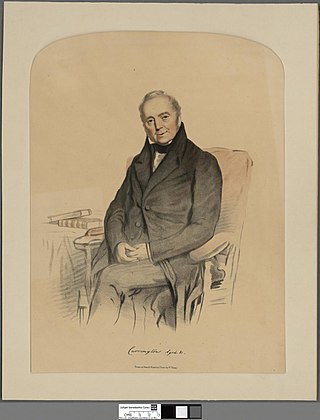
Baron Carrington is a title that has been created three times, once in the Peerage of England, once in the Peerage of Ireland and once in the Peerage of Great Britain.

Baron Hardinge of Penshurst, in the County of Kent, is a title in the Peerage of the United Kingdom. It was created in 1910 for the diplomat the Hon. Sir Charles Hardinge, Viceroy and Governor-General of India from 1910 to 1916. He was the second son of Charles Hardinge, 2nd Viscount Hardinge. His son, the second Baron, served as private secretary to both King Edward VIII and King George VI.
Baron Addington, of Addington in the County of Buckingham, is a title in the Peerage of the United Kingdom. It was created on 22 July 1887 for the businessman and Conservative Member of Parliament, John Hubbard. He was head of the firm of John Hubbard & Co and also sat as a Member of Parliament for Buckingham and the City of London. His eldest son, the second Baron, was a partner in the family firm and represented Buckingham in the House of Commons as a Conservative. He was succeeded by his eldest son, the third Baron. He was three times Mayor of Buckingham. On the death of his younger brother, the fourth Baron, the line of the eldest son of the first Baron failed. The title passed to their first cousin once removed, the fifth Baron. He was the grandson of Cecil John Hubbard, third son of the first Baron. As of 2018, the title is held by his eldest son, the sixth Baron. He is one of the ninety elected hereditary peers that remain in the House of Lords after the passing of the House of Lords Act of 1999. Lord Addington sits on the Liberal Democrat benches.
Baron Fermoy is a title in the Peerage of Ireland. The title was created by Queen Victoria by letters patent of 10 September 1856 for Edmond Roche.
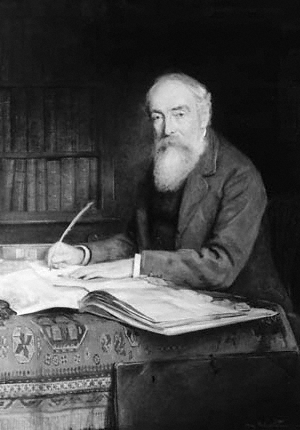
George Edward Cokayne,, was an English genealogist and long-serving herald at the College of Arms in London, who eventually rose to the rank of Clarenceux King of Arms. He wrote such authoritative and standard reference works as The Complete Peerage and The Complete Baronetage.

Baron Garvagh, of Garvagh in the County Londonderry, is a title in the Peerage of Ireland. It was created in 1818 for George Canning. He had previously represented Sligo and Petersfield in Parliament and also served as Lord Lieutenant of County Londonderry. Canning was the first cousin of both Prime Minister George Canning and the diplomat Stratford Canning, 1st Viscount Stratford de Redcliffe. The title is currently held by his great-great-great-grandson, the sixth Baron, who succeeded his father in 2013.
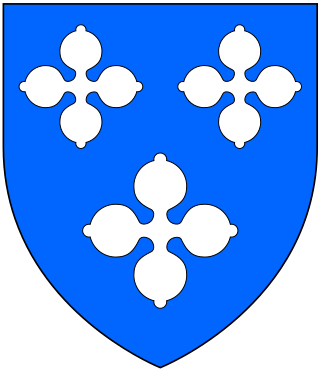
Viscount D'Abernon, of Esher and of Stoke d'Abernon in the County of Surrey, was a title in the Peerage of the United Kingdom. It was created on 20 February 1926 for the politician, diplomat and writer Edgar Vincent, 1st Baron D'Abernon who had been created Baron D'Abernon, of Esher in the County of Surrey, on 2 July 1914. In 1936 he succeeded his elder brother as sixteenth Baronet, of Stoke d'Abernon. All three titles became extinct on his death in 1941.
Viscount Cullen of Tipperary was a title in the Peerage of Ireland created on 11 August 1642, along with the title Baron Cullen, for Charles Cokayne.

Brien Ibrican Cokayne, 1st Baron Cullen of Ashbourne was a British businessman and banker.
